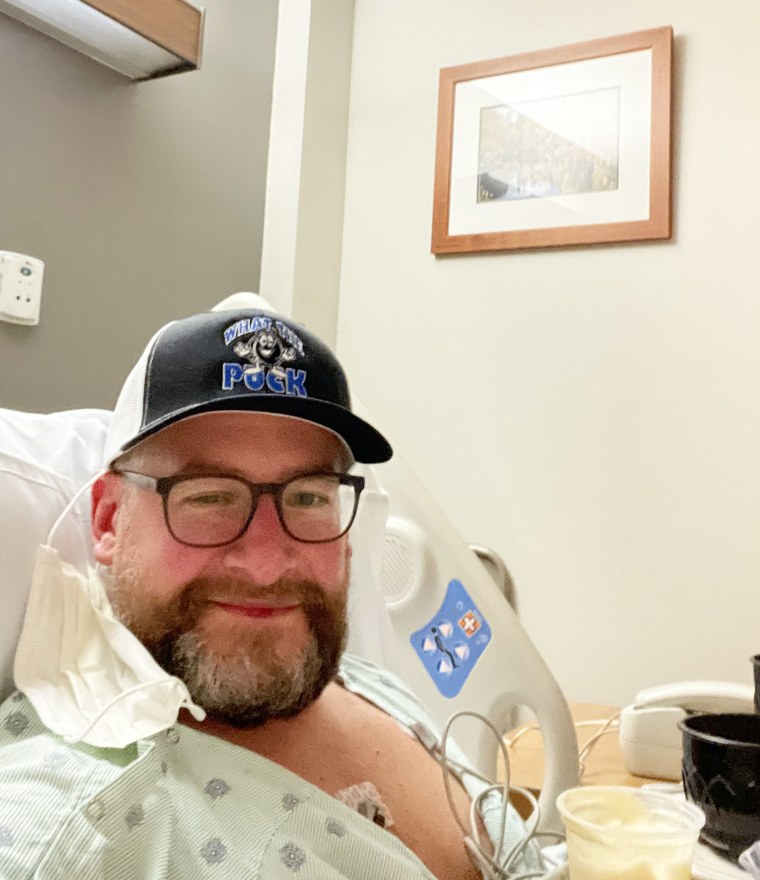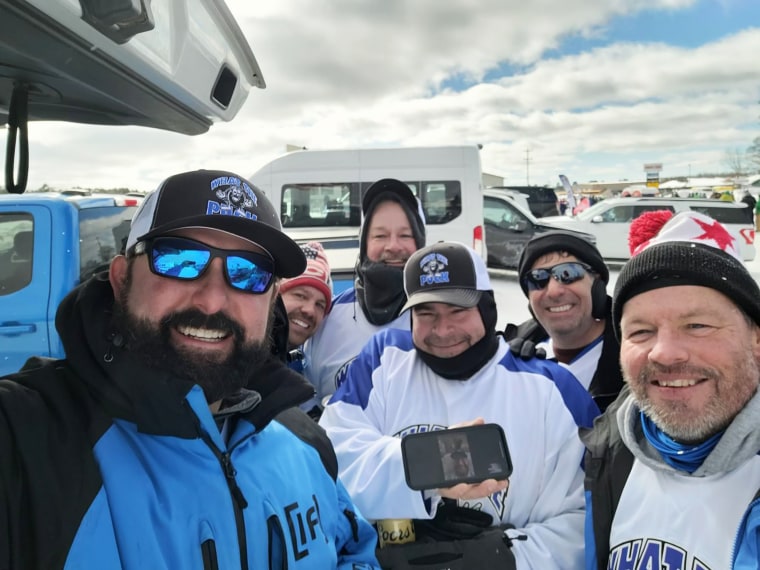The high school technology and engineering teacher was 40 at the time and ready to head out for an annual pond hockey trip with his brother and some friends. But he felt tired, had a quick dizzy spell at his desk and had developed an odd lisp.
“I kept telling myself, I’m going on this big trip, maybe I’m just a little tired and hadn’t slept a lot,” Kenny, now 41, tells TODAY.com. His wife, a counselor at the same school, noticed he was slurring his words a bit and asked if he was OK. But he brushed off her concerns and got in the car.

On the five-and-a-half-hour drive from the Chicago suburbs up to the hockey event in Eagle River, Wisconsin, Kenny couldn’t shake the exhaustion. He napped in the car on the way up while his brother drove, and when they arrived, his lisp was more pronounced.
“My mind kept saying, this just doesn’t seem right,” he recalls, but he still chalked it up to not getting enough sleep and wanted to stick it out to experience the event that the group had waited for all year.
Someone in the group suggested he might have Bell’s palsy, a condition that causes sudden (but usually temporary) facial muscle weakness. But the next day, Kenny went to snowmobile the ice and realized his symptoms were getting worse.
“I go to try and start my sled. I grab with my left hand trying to pull, and I’m like, huh, I’ve got no strength,” he recounts, adding that he’d also had trouble getting his boots on that morning.
At that point, he finally took the guys up on their offer to drive him to urgent care — and Kenny learned just how serious his situation really was.
“The word ‘stroke’ never came to mind.”
At the urgent care center, Kenny was coherent and conscious but found it challenging to speak. “They asked me what was wrong and I could barely get the words out because my lisp was so heavy at that point,” he says.
Initially, the medical staff agreed that he might have Bell’s palsy, but they sent him for a CT scan anyway just to be sure.
“That was my life-changing moment,” Kenny says.
The staff literally ran into his room and told him the CT scan revealed he was actually having a stroke. “I remember the heart monitor that I was hooked up to just started beeping because my heart was going nuts,” Kenny says. “I was shaken.”
Kenny was transferred to a hospital an hour away, and his wife drove through a blizzard to meet him there. The team there performed more tests — including an echocardiogram, which is an ultrasound of the heart — and prescribed medication to keep him safe until he got home to see doctors in Chicago.
But, on the long drive back home, the doctors called Kenny to tell him the news: The echocardiogram showed bubbles in his heart, a telltale sign that he had a relatively common congenital heart condition known as a patent foramen ovale, which likely contributed to his stroke.
What is a patent foramen ovale?
A PFO is a flap-like hole in the tissue between the two upper chambers of the heart that may allow blood to flow between them.
On its own, a PFO isn’t necessarily a cause for concern. In fact, everyone is born with a PFO, Dr. Atman P. Shah, clinical director of cardiology and co-director of the cardiac catheterization laboratory at the University of Chicago, tells TODAY.com.
In the womb, “we don’t really need our lungs,” Shah explains, “because we’re just swimming in amniotic fluid.”
During that time, fresh oxygenated blood comes to the right side of the heart and, instead of going through the lungs, passes through a PFO to the left side of the heart, Shah says. From there, it circulates throughout the fetus.
And when we’re born, the PFO typically closes on its own.
“When we take our first breath, our lungs inflate and the PFO slaps shut,” Dr. Mingming Ning, associate professor and director of the cardio-neurology clinic at Massachusetts General Hospital, tells TODAY.com.
But, in one in four people, that PFO doesn’t actually close. Many of those people live their whole lives without ever knowing they have a PFO. But, for others, their PFO contributes to serious health issues— including strokes and migraine attacks.
If you develop a clot in your leg, for instance, that can break off and travel up to the lungs, where it might get broken up more, Shah says. “But if there’s a PFO, those clots can transit directly to the left side of the heart, which is responsible for supplying blood to the brain and other vital organs and muscles,” he explains.
The PFO makes it easier for clots from elsewhere in the body to travel up an artery directly to the brain, which causes a stroke.
An opening in the heart like this may also allow homocysteine, a naturally occurring amino acid that encourages clotting, to go through the heart without being deactivated by the lungs like normal, Ning explains.
“It’s not just a hole that allows a clot to go through,” she says. It actually can change the blood’s chemistry, making it more likely to develop abnormal clots in the future, Ning adds.
Still, Ning wants to reassure people that, because PFO-related strokes are “opportunistic,” simple precautions to prevent clots can help prevent those events. For example, she recommends staying hydrated, keeping physically active and getting screened for clot risks before taking hormonal birth control pills.
The frontier of research right now is looking for ways to determine, out of the billions of people on the planet with a PFO, who has a benign PFO and who is likely to develop a stroke or other complication, she explains.

Treatment for PFO after a stroke
In people like Kenny who have a PFO and have survived a stroke, the first step is to connect with a neurologist who will order an exhaustive list of tests to look for other factors that may have led to the stroke. Kenny also wore a heart monitor on his chest for 30 days.
Once the team determines that the PFO was the major contributing factor to the stroke, patients have a choice, Shah says: They can take powerful blood thinners for the rest of their life or they may be a good candidate to have the PFO closed with a small implanted device.
There are a few similar PFO closure devices on the market that come in different sizes and, generally, all work the same way, Shah says. For Kenny, the choice was clear, and he received an Abbott Amplatzer Talisman device in mid-April 2023.
First, a tiny catheter is inserted into a vein in the patient’s leg, which goes all the way up to the right atrium of the heart. Using a specialized ultrasound probe, the medical team is able to precisely place the catheter through the PFO. From there, the team sends the small device into place via the catheter.
The device “looks like two frisbees connected by a pin,” says Shah, who implanted Kenny’s device. One frisbee sits on either side of the PFO, “so we’re kind of making a heart sandwich,” he adds. Once the team is comfortable with how the device is sitting, they unscrew it and leave it in place permanently.
Ning notes that not everyone with a PFO who’s had a stroke is eligible to have their devices covered by insurance because the original clinical trials of the devices excluded people in certain groups, she says, such as those with genetic risks for blood clotting and people over the age of 60 who have increased risk for atrial fibrillation.
That doesn’t mean people in those groups should not get treatment, especially because PFO-related strokes can happen at any age, Ning explains. But, as always, their treatment should be individualized based on their specific case and risk factors.
Healing and recovering — physically and mentally
For Kenny, the PFO closure was instrumental in also bringing him mental and emotional closure about his massive health scare.
As a passionate educator, he says it was hard to be away from the classroom for three months. “I remember my wife would come in and set my laptop up and turn it on. … I had tears looking at the kids,” Kenny recalls.
He also had to take a break from hockey. And his 11-year-old daughter was concerned about her dad, especially because it was hard for him to speak in the days following the stroke and he felt extremely exhausted.
Looking back now, Kenny knows all the signs of a stroke were there in the classroom on the first day. And he urges other people not to brush worrying symptoms like those aside.
“I will live with the fact if I had listened to my body and listened to the signs and been aware of this, I never would have gotten in the car in the parking lot,” he says. “I would have stayed home. I would have been with my wife and I would have (gone) to the hospital.”
The idea that he could have been having a stroke at 40 “never occurred to me,” he says.
Coming to terms with the fact that he did have a stroke was part of his recovery. “It took a long time for me to be able to say the words, ‘I had a stroke,'” Kenny says, because he was worried that he would be judged for having a health issue like this so young.
However, as an engineering teacher, he says finding a reason for his stroke and a treatment for it helped pull him through and out of that mental hole. “I look at things from logic,” he says. “If someone’s broke, how do we fix it?”

Recovery from the PFO closure was relatively easy, he says. He spent the night in the hospital and went home the next day. Generally, patients are told to avoid lifting anything over 15 pounds for about a week to avoid popping the healing vein in the leg, Shah says. And they’ll likely go on to take baby aspirin for the rest of their lives to reduce the risk for a clot-related stroke, he adds.
Gradually, Kenny was able to hit his personal recovery milestones, including seeing his students, putting his ice skates back on and being able to go for a run again. And, about six months after his stroke, Kenny returned to Eagle River with his family and one of the members of his pond hockey group.
He woke up early and ran a lap around the lake where they play, down the road and back to where they were staying. Kenny calls it his “yes moment,” a reminder that he could still do all the things he loved. “It was an astonishing feeling,” he says.




